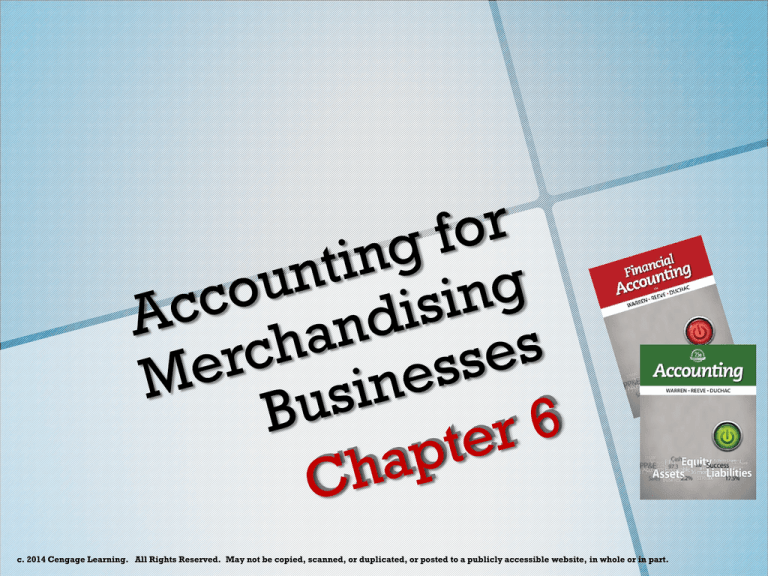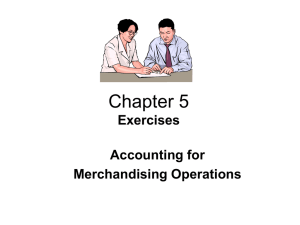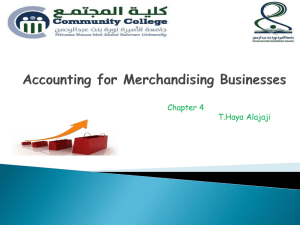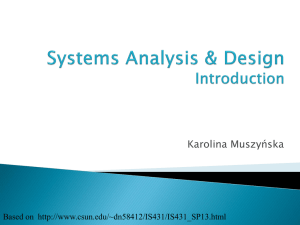
c. 2014 Cengage Learning. All Rights Reserved. May not be copied, scanned, or duplicated, or posted to a publicly accessible website, in whole or in part.
Learning Objectives
1. Distinguish between the activities and financial
2.
3.
4.
5.
statements of service and merchandising
businesses.
Describe and illustrate the accounting for
merchandise transactions.
Describe and illustrate the financial statements of
a merchandising business.
Describe the adjusting and closing process for a
merchandising business.
Describe and illustrate the use of the ratio of net
sales to assets in evaluating a company’s
operating performance.
c. 2014 Cengage Learning. All Rights Reserved. May not be copied, scanned, or duplicated, or posted to a publicly accessible website, in whole or in part.
Nature of Merchandising Businesses
Service Business
Fees earned
Operating expenses
Net income
$XXX
–XXX
$XXX
Nature of Merchandising Businesses
Merchandising Business
Sales
Cost of Merchandise Sold
Gross Profit
Operating Expenses
Net Income
$XXX
–XXX
$XXX
–XXX
$XXX
Nature of Merchandising Businesses
o When merchandise is sold, the revenue is
reported as sales, and its cost is recognized as
an expense called cost of merchandise sold.
Gross
Profit
Nature of Merchandising Businesses
o The cost of merchandise sold is subtracted
from sales to arrive at gross profit. It is the
profit before deducting operating expenses.
Gross
Profit
Nature of Merchandising Businesses
o Merchandise on hand (not sold) at the end of
an accounting period is called merchandise
inventory.
NATURE OF
MERCHANDISING
BUSINESSES
c. 2014 Cengage Learning. All Rights Reserved. May not be copied, scanned, or duplicated, or posted to a publicly accessible website, in whole or in part.
Purchase Transactions
o If merchandise inventory at the end of the
period is determined by taking a physical
count of inventory on hand, a periodic
inventory system is being used.
Purchase Transactions
o Under the perpetual inventory system, the
amounts of inventory purchased, available for
sale, and sold are continuously (perpetually)
updated in the inventory records.
Purchase Transactions
o On January 3, NetSolutions purchased
merchandise for cash.
*
NOTE: We will assume a perpetual
inventory system is used.
Purchase Transactions
o On January 4, NetSolutions purchased
merchandise on account from Thomas
Corporation.
Credit Terms
o To encourage the buyer to pay before the end
of the credit period, the seller may offer a
discount. Credit terms of 2/10, n/30 are
summarized in the next slide (Exhibit 2).
Purchases Discounts
o A buyer may receive a discount from the seller
(sales discount) for early payment of the
amount owed. From the buyer’s perspective,
such discounts are called purchases discounts.
Purchase Transactions
o Alpha Technologies issues an invoice for
$3,000 to NetSolutions dated January 5, with
terms 2/10, n/30. NetSolutions is trying to
determine if it should pay the invoice within
the discount period.
Purchase Transactions
o If NetSolutions can borrow cash at an annual
interest rate of 6%, should the firm borrow
cash to pay the invoice within the discount
period?
Discount of 2% on $3,000
Interest for 20 days at the rate
of 6% on $2,940
Savings from borrowing
YES
$60.00
– 9.80
$50.20
Purchase Transactions
o Alpha Technologies issued an invoice for
$3,000 to NetSolutions dated January 5, with
terms 2/10, n/30. Based on the calculation in
the previous slide, NetSolutions pays the
amount due, less the discount, on January 15.
Discount Not Taken
o Assume that, instead of paying the invoice
within the discount period, NetSolutions pays
the invoice on February 4.
Purchases Returns and Allowances
o A purchases return involves actually returning
merchandise that is damaged or does not meet
the specifications of the order. From a buyer’s
perspective, such returns are called purchases
returns and allowances.
Debit Memo
o A debit memorandum, often called a debit
memo, informs the seller of the amount the
buyer proposes to debit to the account
payable due the seller.
Debit Memo
o NetSolutions records the return of the
merchandise indicated in the debit memo in
Exhibit 3 as follows:
Merchandise Purchased
o On May 2, NetSolutions purchased $5,000 of
merchandise on account from Delta Data Link,
terms 2/10, n/30.
Merchandise Returned
o On May 4 , NetSolutions returned $3,000 of the
merchandise purchased from Delta Data Link.
Invoice Paid
o On May 12, NetSolutions paid for the purchase
of May 2 less the return and discount.
Cash Sales
o On March 3, NetSolutions sold $1,800 of
merchandise for cash.
Cash Sales
o Using the perpetual inventory system, the cost
of merchandise sold and the decrease in
merchandise inventory are also recorded. The
cost of merchandise sold on March 3 is $1,200.
Cash Sales
o Sales made to customers using credit cards are
recorded as cash sales. Assume that
NetSolutions paid credit card processing fees
of $4,150 on March 31.
Sales on Account
o On March 10, NetSolutions sold merchandise
on account for $18,000. The cost of
merchandise sold was $10,800.
Sales Discounts
o The terms for when payments for merchandise
are to be made are called credit terms. If
payment is required on delivery, the terms are
cash or net cash. Otherwise, the buyer is
allowed an amount of time, known as the credit
period, in which to pay.
Receipts on Account
o On March 19, NetSolutions receives the amount
due within ten days, so the buyer deducted
$360 ($18,000 x 2%) from the invoice amount.
Credit Memo
o A credit memorandum, often called a credit
memo, authorizes a credit to (decreases) the
buyer’s account receivable. An example of a
credit memo issued by NetSolutions is shown
in Exhibit 4 (next slide).
Credit Memo
o On April 13, issued Credit Memo No. 321 to
Krier Company for merchandise returned to
NetSolutions. Selling price, $2,250; cost to
NetSolutions, $1,600.
Freight
o If ownership of the merchandise passes to the
buyer when the seller delivers the
merchandise to the freight carrier, the terms
are said to be FOB (free on board) shipping
point.
Freight
o On June 10, NetSolutions buys merchandise
from Magna Data on account, $900, terms FOB
shipping point and pays the shipping cost of
$50.
Freight
o If ownership of the merchandise passes to the
buyer when the buyer receives the
merchandise, the terms are said to be FOB
(free on board) destination.
Sale Plus Freight Cost
o On June 15, NetSolutions sells merchandise to
Kranz Company on account, $700, terms FOB
destination. The cost of the merchandise sold
is $480.
Sale Plus Freight Cost
o On June 15, NetSolutions pays freight of $40 on
the sale of June 15.
Seller Prepays Freight
o On June 20, NetSolutions sells merchandise to
Planter Company on account, $800, terms FOB
shipping point. NetSolutions paid freight of
$45, which was added to the invoice. The cost
of the merchandise sold is $360.
Seller Prepays Freight
FREIGHT TERMS
FREIGHT TERMS
SUMMARY:
RECORDING
MERCHANDISE
INVENTORY
DUAL NATURE OF
MERCHANDISE
TRANSACTIONS
DUAL NATURE OF
MERCHANDISE
TRANSACTIONS
DUAL NATURE OF
MERCHANDISE
TRANSACTIONS
DUAL NATURE OF
MERCHANDISE
TRANSACTIONS
DUAL NATURE OF
MERCHANDISE
TRANSACTIONS
DUAL NATURE OF
MERCHANDISE
TRANSACTIONS
DUAL NATURE OF
MERCHANDISE
TRANSACTIONS
DUAL NATURE OF
MERCHANDISE
TRANSACTIONS
CHART OF
ACCOUNTS
Sales Taxes
o On August 12, merchandise is sold on account
to Lemon Company, $100. The state has a 6%
sales tax.
Sales Taxes
o On a regular basis, the seller pays to the taxing
authority (state) the amount of the sales taxes
collected.
Trade Discounts
o When wholesalers offer special discounts to
certain classes of buyers who order large
quantities, these discounts are called trade
discounts.
c. 2014 Cengage Learning. All Rights Reserved. May not be copied, scanned, or duplicated, or posted to a publicly accessible website, in whole or in part.
Multiple-Step Income Statement
o The multiple-step income statement contains
several sections, subsections, and subtotals.
REVENUE FROM
SALES
Revenue from Sales
o Sales is the total amount charged customers for
merchandise sold, including cash sales and
sales on account.
Revenue from Sales
o Sales returns and allowances are granted by
the seller to customers for damaged or
defective merchandise.
Revenue from Sales
o Sales discounts are granted by the seller to
customers for early payment of amounts owed.
Revenue from Sales
o Net sales is determined by subtracting sales
returns and allowances and sales discounts
from sales.
Cost of Merchandise Sold
o The cost of merchandise sold is the cost of the
merchandise sold to customers. Merchandise
costs consist of all the costs of acquiring the
merchandise and readying it for sale, such as
purchase and freight costs.
MULTIPLE-STEP
INCOME
STATEMENT
MULTIPLE-STEP
INCOME
STATEMENT
INCOME FROM OPERATIONS
Selling expenses are
incurred directly in the
selling of merchandise.
Sales salaries
Delivery expense
Store supplies used
Depreciation of store
equipment
Advertising expense
INCOME FROM OPERATIONS
Administrative
expenses, sometimes
called general
expenses, are incurred
in the administration or
general operations of
the business.
Office salaries
Office supplies used
Depreciation of office
equipment
MULTIPLE-STEP
INCOME
STATEMENT
Multiple-Step Income Statement
o Income from operations, sometimes called
operating income, is determined by
subtracting operating expenses from gross
profit.
MULTIPLE-STEP
INCOME
STATEMENT
Other Income and Expense
o Other income is revenue from sources other
than the primary operating activity of a
business.
o Other expense is an expense that cannot be
traced directly to the normal operations of the
business.
MULTIPLE-STEP
INCOME
STATEMENT
Single-Step Income Statement
o An alternative form of income statement is the
single-step income statement. As shown in the
next slide, the income statement for
NetSolutions deducts the total of all expenses
in one step from the total of all revenues.
SINGLE-STEP
INCOME
STATEMENT
STATEMENT OF
OWNER’S EQUITY
Balance Sheet
o The form of balance sheet with the assets on
the left-hand side and the liabilities and
owner’s equity on the right-hand side is called
the account form.
Balance Sheet
o When the balance sheet is presented in a
downward sequence in three sections, it has
been prepared using the report form. This is
the form used in the next two slides.
BALANCE SHEET
(continued)
BALANCE SHEET
c. 2014 Cengage Learning. All Rights Reserved. May not be copied, scanned, or duplicated, or posted to a publicly accessible website, in whole or in part.
Adjusting Entry for Inventory Shrinkage
o Merchandising businesses may experience
some loss of inventory due to shoplifting,
employee theft, or errors in recording or
counting inventory.
Adjusting Entry for Inventory Shrinkage
o If the balance of the Merchandise Inventory
account is larger than the total amount of the
merchandise count, the difference is often
called inventory shrinkage or inventory
shortage.
Inventory Shrinkage
o NetSolutions’ inventory records indicate the
following on December 31, 2015:
Dec. 31, 2015
Account balance of Merchandise Inventory
$63,950
Physical merchandise inventory on hand
62,150
Inventory shrinkage
$ 1,800
Inventory Shrinkage
o At the end of the accounting period, inventory
shrinkage is recorded by the following
adjusting entry:
Step 1: Closing Entries
o Debit each temporary account with a credit
balance, such as Sales, for its balance and
credit Income Summary.
Step 2: Closing Entries
o Credit each temporary account with a debit
balance, such as an expense, for its balance
and debit Income Summary.
Step 3: Closing Entries
o Debit Income Summary for the amount of its
balance (net income) and credit the owner’s
capital account.
Step 4: Closing Entries
o Debit the owner’s capital account for the
balance of the drawing account and credit the
drawing account.
Closing Entries
o NetSolutions’ Income Summary account after
the closing entries have been posted is as
follows:
c. 2014 Cengage Learning. All Rights Reserved. May not be copied, scanned, or duplicated, or posted to a publicly accessible website, in whole or in part.
Ratio of Net Sales to Assets
o The ratio of net sales to assets measures how
effectively a business is using its assets to
generate sales.
Ratio of Net
Net Sales
Sales to =
Average Total Assets
Assets
Ratio of Net Sales to Assets
o The following data (in millions) were taken
from the annual reports of Dollar Tree, Inc.:
Ratio of Net Sales to Assets
o The ratio of net sales to assets for each year are
as follows:
c. 2014 Cengage Learning. All Rights Reserved. May not be copied, scanned, or duplicated, or posted to a publicly accessible website, in whole or in part.
PERIODIC
INVENTORY SYSTEM
Recording Merchandise Transactions
o Purchases. Purchases of inventory are
recorded in a purchases account rather than in
the merchandise inventory account.
Recording Merchandise Transactions
o Purchases Discounts. Purchases discounts are
normally recorded in a separate purchases
discounts account. The balance of the
purchases discounts account is reported as a
deduction from Purchases for the period.
Recording Merchandise Transactions
o Purchases Returns and Allowances. Purchases
returns and allowances are recorded in a
similar manner as purchase discounts.
Recording Merchandise Transactions
o Freight In. When merchandise is purchased
FOB shipping point, the buyer pays for the
freight. Under the periodic inventory system,
freight paid when purchasing merchandise
FOB shipping point is debited to Freight In.
(continued)
(concluded)
CLOSING ENTRIES
(continued)
CLOSING ENTRIES
(continued)
CLOSING ENTRIES
(concluded)
c. 2014 Cengage Learning. All Rights Reserved. May not be copied, scanned, or duplicated, or posted to a publicly accessible website, in whole or in part.








